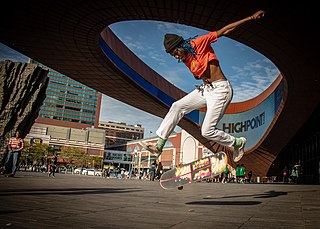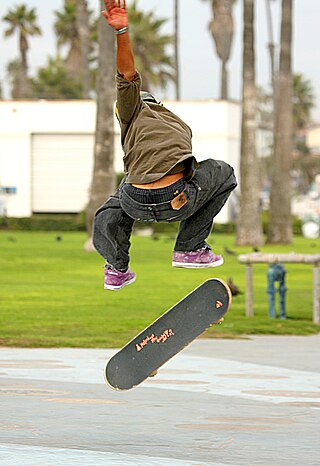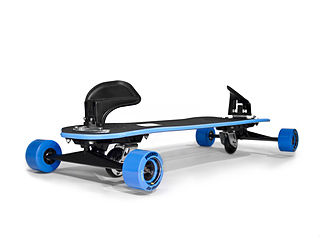
Skateboarding is an action sport that involves riding and performing tricks using a skateboard, as well as a recreational activity, an art form, an entertainment industry job, and a method of transportation. Originating in the United States, skateboarding has been shaped and influenced by many skateboarders throughout the years. A 2009 report found that the skateboarding market is worth an estimated $4.8 billion in annual revenue, with 11.08 million active skateboarders in the world. In 2016, it was announced that skateboarding would be represented at the 2020 Summer Olympics in Tokyo, for both male and female teams.
Boardsports are active outdoor sports that are played with some sort of board as the primary equipment. These sports take place on a variety of terrains, from paved flat-ground and snow-covered hills to water and air. Most boardsports are considered action sports or extreme sports, and thus often appeal to youth. Some board sports were marginalized in the past. However, many board sports are gaining mainstream recognition, and with this recognition, they have enjoyed wider broadcast, sponsorship and inclusion in institutional sporting events, including the Olympic Games.

A surfboard is a narrow plank used in surfing. Surfboards are relatively light, but are strong enough to support an individual standing on them while riding an ocean wave. They were invented in ancient Hawaii, where they were known as papa he'e nalu in the Hawaiian language, and were usually made of wood from local trees, such as koa. They were often over 460 cm (15 ft) in length and extremely heavy. Major advances over the years include the addition of one or more fins (skegs) on the bottom rear of the board to improve directional stability, and numerous improvements in materials and shape.

Wakeskating is a water sport and an adaptation of wakeboarding that employs a similar design of board manufactured from maple or fibreglass. Unlike wakeboarding, the rider is not bound to the board in any way, similar to the skateboard, from which the name derives.

A longboard is a type of skateboard typified by longer decks and wheelbases, larger-diameter and softer (lower-durometer) wheels, and often lower riding height compared to street skateboards, though there is wide variation in the geometry and construction of longboards. Among the earliest types of skateboards, longboards were inspired by surfing, with early longboards drawing from the design of surfboards, resembling and mimicking the motion of riding a surfboard, but adapted to riding on streets in a practice known as sidewalk surfing.

Longboarding is a variation of skateboarding typified by the use of longer boards ("decks") with longer wheelbases and softer wheels. While longboards vary widely in shape and size, compared to street skateboards longboards are designed to be more stable at speed and to have more traction due to larger wheel sizes and softer wheel durometers. While standard street skateboards may typically be between 28 and 34 inches long, longboards can range anywhere from 32 to 50 inches in length. Ride characteristics of longboards generally differ from that of street skateboards due to the use of specialized longboard trucks that have different properties than those typically used with skateboards; while street skateboards use "traditional kingpin" (TKP) trucks that are optimized for tight turning radii, ollie and flip tricks, slides, grinds, and transition skating, longboards are typically paired with "reverse kingpin" (RKP) trucks that are designed for increased stability at higher speeds, more "surfy" carving characteristics, and/or greater ride comfort for commuting over longer distances.

Mountainboarding ]] Mountainboarding, also known as dirtboarding, off-road boarding, and All-Terrain Boarding (ATB), is a well-established, but little-known action sport derived from snowboarding. The sport was initially pioneered by James Stanley during a visit to the Matterhorn in the 1990s, where snow was not available. A mountainboard is made up of components including a deck, bindings, four wheels with pneumatic tires, and two steering mechanisms known as trucks. Mountainboarders, also known as riders, ride specifically designed boardercross tracks, slopestyle parks, grass hills, woodlands, gravel tracks, streets, skateparks, ski resorts, BMX courses, and mountain bike trails. It is this ability to ride such a variety of terrain that makes mountainboarding unique from other board sports.

A snowskate is a hybrid of a skateboard and a snowboard, intended primarily to allow for skateboard-style tricks on the snow. There are many types depending on the brand or style of snowskate.
Charitable distance skating refers to long-distance travel on a longboard or skateboard with an associated charitable fundraising effort.

A skateboard is a type of sports equipment used for skateboarding. It is usually made of a specially designed 7–8-ply maple plywood deck and has polyurethane wheels attached to the underside by a pair of skateboarding trucks.
A fingerboard is a scaled-down replica of a skateboard that a person "rides" with their fingers, rather than their feet. A fingerboard is typically 100 millimeters (3.9 in) long with width ranging from 26 to 55 mm, with graphics, trucks and plastic or ball-bearing wheels, like a skateboard. A fingerboard can be used to do traditional skateboarding tricks, such as an ollie and kickflip.
A skateboard style refers to the way a skateboarder prefers to ride a skateboard. Skateboard styles can be broadly divided into two different categories: skateboarding to perform tricks and skateboarding as a means of transportation. Styles of skateboarding have evolved and are influenced by a number of factors including sociocultural evolution, mass media, music, technology, corporate influence and individual skill level.

Slalom skateboarding is a form of downhill skateboard racing that first appeared in the 1960s and 1970s and has made a resurgence in popularity in the 2000s. Slalom racers skate down a course usually marked by plastic cones. The racer tries to get through the course with the fastest time, while knocking down the fewest cones. Each cone typically carries a penalty of a fraction of a second which is added to the skater's time.

A freeboard is a specialist skateboard designed to closely simulate the behavior of a snowboard. Freeboards were developed to allow snowboarders to transition to skateboarding without the need to adapt to a smaller deck and narrower wheel-base.

Rayne Longboards is a Canadian longboard manufacturer. Rayne Longboards are shipped to retail shops in many countries, and they are also sold through their online store. The specialized boards are made for downhill racing, freeriding, city riding, and long distance pushing.

An electric skateboard is a personal transporter based on a skateboard. The speed is usually controlled by a wireless hand-held throttle remote, or rider body weight-shifting between front of the board for forward motion and rear for braking. As for the direction of travel to the right or left, it is adjusted by tilting the board to one side or the other. The classification of electric skateboards and legality of their use on roads or pavements varies between countries.

Street skateboarding is a skateboarding discipline which focuses on flat-ground tricks, grinds, slides and aerials within urban environments, and public spaces. Street skateboarders meet, skate, and hang out in and around urban areas referred to as "spots," which are commonly streets, plazas or industrial areas. To add variety and complexity to street skateboarding, obstacles such as handrails, stairs, walls, flower beds, bins, park benches, picnic tables, and other street furniture may be traversed as single tricks or as part of a series of consecutive tricks called a "line."
Hamboards manufactures and sells rail-to-rail Surfskates, SUPskates, Paddles and Accessories. Most Hamboards are longer, wider and sit higher off the ground than conventional skateboards and longboards. Hamboards also turn much more than conventional skateboards. The enabling technology are the patented Hamboards Surfskate Trucks (HST), featuring 30 degrees of roll, which allows these huge boards to track and pump aggressive surf-style carving maneuvers. The patented Street Sweeper SUPskate Paddle flexes significantly, allowing the user to spring themselves along with comfort.
Penny Skateboards is Australian skateboard manufacturing companies founded in 2010 by Ben Mackay in Brisbane.














